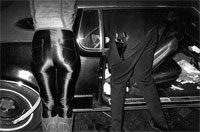In an era when the New York City Police Department (NYPD) has an entire arsenal of high-tech weapons and techniques to fight crime and terrorism, seeing Jill Freedman’s gritty, in-your-face images of street cops on the job thirty years ago almost makes you wish for the good old days when it seemed easier to spot and take out the bad guys. After all, this was the period when Times Square was best known for its prostitutes, scam artists and porn palaces. This was the heyday of Alphabet City in the East Village, the junkie’s back yard. This was the New York that Jill Freedman captured so vividly in her much acclaimed book Street Cops 1978-81.
To get close to the action, Freedman talked her way into riding in the back of patrol cars in the Times Square area as well as downtown in the East Village. And these pictures showed that she went everywhere, from bloody murder scenes to the booking of a bank robber.
Freedman was a legendary street shooter back then, her acknowledged influences—Weegee and Diane Arbus—very evident in her work. And her ability to empathize with her subjects, whether they were cops or streetwalkers, made her pictures all the more realistic. This is quite apparent in many of the 27 vintage black and white prints from the book now on display at Higher Pictures, a gallery located in the tony section of Madison Avenue–not a neighborhood where you would have expected to find the decidedly down-to-earth and downtown Freedman.
The photographs in Street Cops transported me into a world most people don’t get to see —the scary confrontations with deranged people; or two cops waiting outside a door with guns drawn with one of them holding a lit cigar at his side; a bank robber being booked at the station house with cops all around laughing; a stabbing victim staring wide-eyed at the camera. Freedman’s pithy, descriptive captions (She had been an ad copywriter in a previous life) made the photographs more meaningful, i.e., a photo of a cop talking to a streetwalker is captioned “Pity the poor working girl.” Another photo/caption that I liked had a different point of view: Freedman is standing behind the perp, so we see two cops facing what could become a dangerous situation—the caption says, “Restraint.”
All in all, Jill Freedman’s photographs show a New York City that’s far different than the one we know today. Weegee would have approved.
More information available at: http://www.nyphotoreview.com/NYPR_REVS/NYPR_REV1677.html

